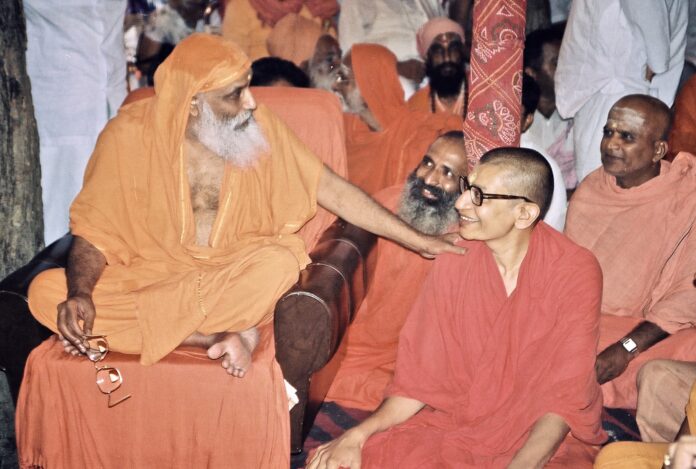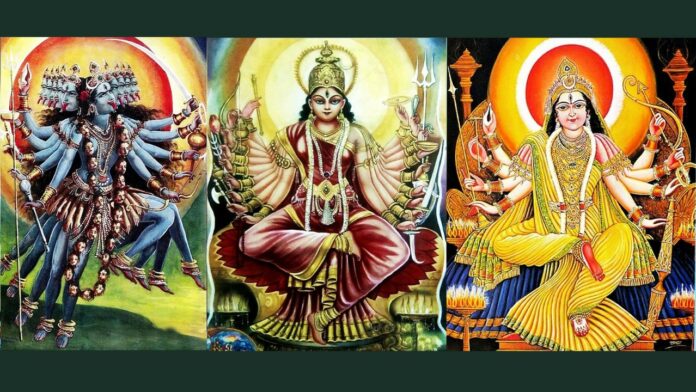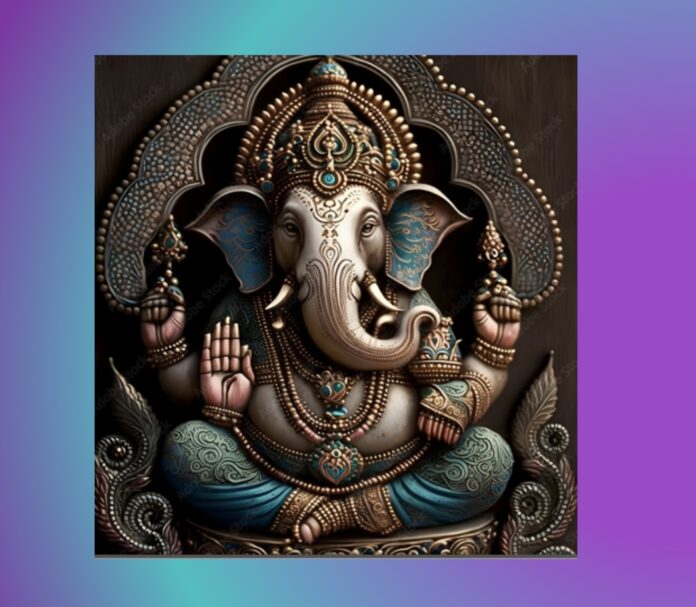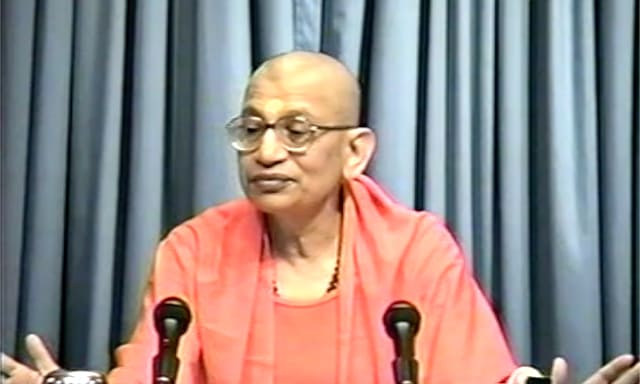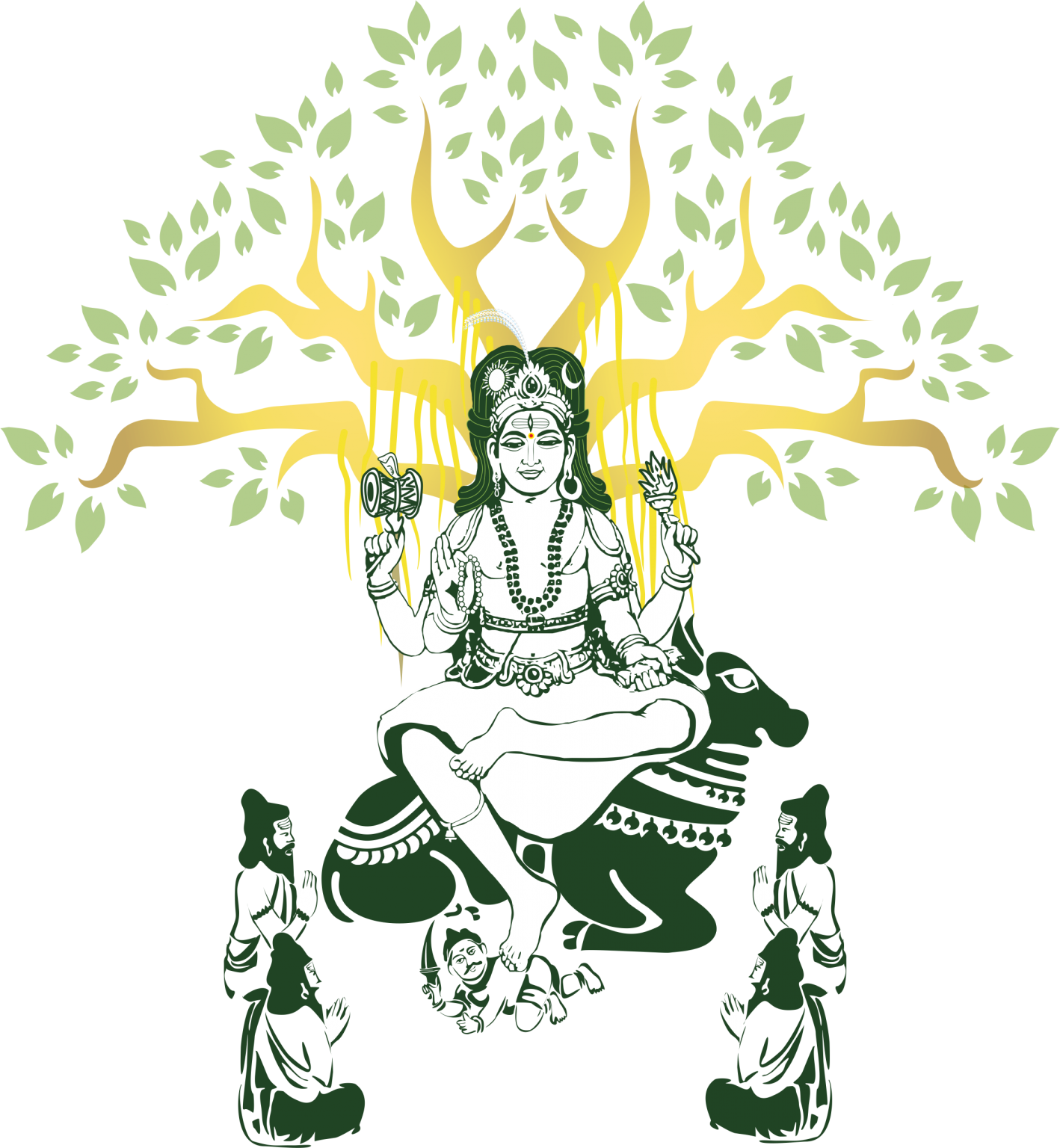Satsang with Sri Swami Viditatmananda Saraswati
2000 Gurupūrṇimā Talk transcribed by Deepa Shankar. Edited by Krishnakumar (KK) S. Davey and Jayshree Ramakrishnan.
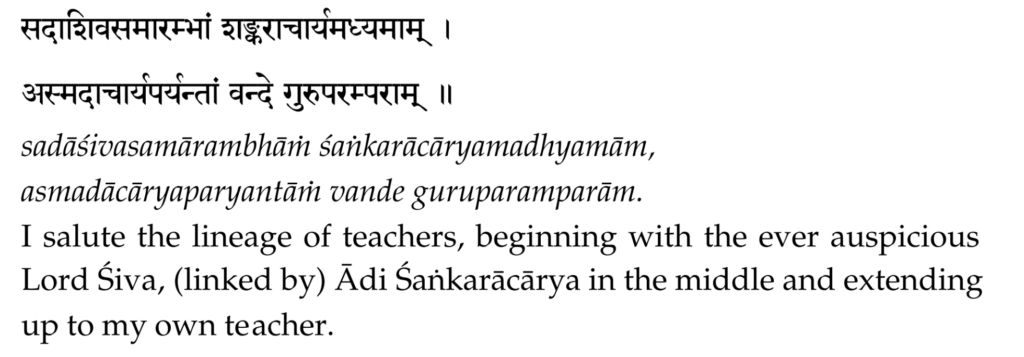
Vande guruparamparām, I offer my salutations to this paramparā, the lineage of the gurus, teachers. There are two kinds of lineages: the parental lineage from the father to the son and the lineage of the guru to the disciple. This lineage from the guru to the disciple is as valid a lineage as the parental one.
Sadāśivasamārambhām. I offer my salutations to the lineage of teachers, which has an extremely auspicious beginning with Sadāśiva or Lord Śiva. Śaṅkarācāryamadhyamām. This lineage has Śrī Śaṅkarācārya in the middle and then comes down to our own teachers, asmadāchāryaparyantām.
Everything about Lord Śiva is associated with knowledge
Lord Śiva is the Lord of knowledge. Everything in his form is associated with knowledge. The fire that emerged from the third eye of Lord Śiva is the fire of knowledge. That fire burnt Kāmadeva, the Lord of Passion, to ashes. Kāma or desire is the direct product of avidyā, ignorance, and kāma, in turn, leads to karma, action. Kāma is a tremendous burden and is the source of all our problems such as krodha, anger, lobha, greed, moha, delusion, mada, pride, and mātsarya, jealousy. Kāma is the manifest form of ignorance and can be dispelled only by knowledge. Kāma is a big burden for the ignorant person and is the cause of all his sufferings. However, in light of knowledge it becomes an ornament to the wise person.
Lord Śiva smears his body with the ashes of Kāmadeva.
The Ganges emerges from the matted hair of Lord Śiva. It represents the perennial flow of knowledge. Just as the Ganges flows from the head of Lord Śiva, so also, knowledge flows from the head of the teacher.
Lord Śiva has poison in his neck and, therefore, he is called Nīlakaṇöha, one whose neck is nīla, blue. In the famous Purāṇik story, it is described that as though the entire universe was about to be destroyed by the poison that emerged out of the churning of the milky ocean. The universe is supposed to come to an end at an appointed time, but here it appeared as though it would come to an end before its appointed time. Therefore, the devatās, gods, and the asuras, demons, who were churning the milky ocean, ran asking for help. They went to Lord Viṣṇu, Brahmāji, Indra, and others, but nobody was interested in accepting the poison; all of them had taken the jewels that had come out earlier, during the churning of the ocean. According to the story, 14 jewels came out of the milky ocean e.g., Kāmadhenu, the wish-fulfilling cow, Kalpavṛksha, the wish-fulfilling tree etc. They were kept by the ṛṣis and the devatās. Then Lakṣmī Devī, the goddess of prosperity, emerged; Lord Nārāyaṇa took her. The famous horse Uccaiḥśravā came out and Bali took it. Airāvata, the white elephant, came out, and Indra took it. Surā, wine, came out, and the asuras took that. This is how all the ratnas, jewels, came out one by one and they had no difficulty in accepting them.
When the poison came out, however, nobody wanted it. Ultimately, the devatās and the asuras went to Lord Śiva. Lord Śiva is bhuvana-bhaya-bhaìga-vyasanī, one devoted to freeing the world of fear [Śivamahimna Stotram, 14]. When some calamity happens somewhere, he just rushes to that place and rescues everybody from that calamity. Lord Śiva rushed to where the churning was taking place and just drank the poison. Goddess Pārvatī who was present there thought that the poison would destroy him; if the poison were to go down to his heart he could die. She swiftly caught hold of the neck of Lord Śiva and thus, the poison remained held in his neck. Normally, if you have a dark spot in your neck, it is a blemish or a sign of ugliness, but for Lord Śiva, it is a sign of beauty. The symbolism here is that a wise person accepts whatever poison comes to him. In the wake of knowledge, the poison remains poison and does not destroy him. That is, whatever difficulties come, which otherwise would have caused a lot of distress to somebody else, become, in fact, an ornament for the wise person. Thus, we see that Lord Śiva is the embodiment of knowledge.
Lord Śiva is also called Mṛtyuṅjaya, one who has conquered death. That aspect is also very relevant to us. Lord Dakṣiṇāmūrti faces the southern direction. Mūrti means form, and dakṣiṇā is the southern direction and therefore, Lord Dakṣiṇāmūrti is the one facing the southern direction. In the Vedic culture there are presiding deities for everything, including the quarters and the directions. Lord Yama is the presiding deity of the southern quarter, and therefore, the southern direction symbolizes death and ignorance. Having conquered Lord Yama or death, Lord Dakṣiṇāmūrti faces the southern direction.
The lineage of teachers begins with Lord Dakṣiṇāmūrti, an avatāra of Lord Śiva
Sadāśivasamārambhām. Let us see how this jṅāna-paramparā began. Sanatsujāta and his three brothers, Sanaka, Sanandana, and Sanātana, are said to be the sons of Brahmāji, the Creator. They are his mānasa putras. They are not children born through the normal process of birth, but are created through saìkalpa, resolve. Therefore, their birth is a pure birth. When these boys were born, they were totally pure, without any desires, or with total vairāgya, free from any kind of attachment or temptations. Brahmāji was in the process of creation and, therefore, asked them to join him in creation. These four children who were, in fact, sages even as children, were devoid of any desires, and did not want to join their father. All they wanted was knowledge and, therefore, they left in search of a teacher. They went to Lord Nārāyaṇa and found Goddess Lakṣmī massaging his legs. They were surprised to see this kind of luxury; they did not see any vairāgya there and therefore they were dissatisfied. They did not find the right atmosphere in the brahma-loka either, where Brahmāji was listening to the music of Goddess Sarasvatī, conducive for the pursuit of knowledge. Then they went to Kailāsa, the abode of Lord Śiva, and were aghast at seeing that Goddess Pārvatī formed half of his body. They thought that none of these Gods could impart knowledge to them and so they went in the northern direction and performed great penance. In response to their penance, Lord Śiva appeared before them in a form in which they could accept him as the teacher. Lord Śiva appeared before them, seated under a banyan tree, as Lord Dakṣiṇāmūrti.
Aged disciples were around the youthful guru, Dakṣiṇāmūrti, who was seated on the ground under the banyan tree. The Lord sits in a posture such that his left leg is placed on top of his right thigh. He shows the cinmudra sign with his right fingers; it indicates the knowledge of the identity between jīva and īśvara. The index finger stands for the ego, the ahaìkāra of the jīva, the individual; the thumb stands for īśvara, the Lord. The thumb stands for the Lord since the thumb is required for the effective functioning of all the other fingers. The thumb does not require the other fingers, but they are all dependent on the thumb. The other three fingers stand for the saṁsāra, which is made of three guṇas, namely sattva, rajas, and tamas, or the three states of experience, namely the waking state, the dream state and the deep sleep state. By the grace of the Lord, or pūrva-puṇya, if viveka or discrimination arises in the jīva, he turns away from saṁsāra, and towards īśvara.
How did Lord Dakṣiṇāmūrti impart the knowledge to the disciples? The youthful Lord communicates the knowledge of brahman through silence. He conveys the knowledge through total silence by just showing the cinmudrā sign and it seems that the sages are able to understand its significance. This is how Lord Śiva as Lord Dakṣiṇāmūrti, the very first teacher, imparts the brahma-vidyā, the knowledge of brahman, the knowledge of the Self. Thus began the lineage of the teacher and student that has come down to us. It is alright for Lord Dakṣiṇāmūrti to impart this knowledge in silence to those sages. You can imagine the tremendous impact or presence he must have had on his students. Great sages and great people make a significant impression by their very presence. When we are in their company, their very proximity is enough to resolve questions or doubts in our mind. Thus, it is possible that the sages who had the pleasure of having the darśana of Lord Dakṣiṇāmūrti received that knowledge. But that is not enough for us.
The story of Śrī Śaṅkarācārya
If you look at this lineage as a very beautiful necklace, then Śrī Śaṅkarācārya forms its shining pendant. He is said to be an incarnation of Lord Śiva or Lord Dakṣiṇāmūrti. Śrī Śaṅkarācārya’s parents, Śivaguru and Äryambā, did not have a child for a long time and had become very old. They performed a penance and Lord Śiva appeared before them in their dream and asked them what it was that they wanted. They asked for a child. Lord Śiva said, “OK! I will make you an offer. You can either have a son who will live long but will be mediocre, or have a brilliant son who will have a very short life. Which one do you want?” The couple chose a son who would be brilliant, even if he were to be short-lived. Lord Śiva granted their wish and said that he himself would be born as their son. The son was born and was named Śaṅkara, the name of Lord Śiva. He was to have had a lifespan of only eight years. At the age of five, he was given yajṅopavita, the sacred thread, and sent to a gurukulam. In two years, he learnt the entire Vedas and came home at the age of seven. He himself started teaching the Vedas, and told his mother that he wanted to become a renunciate. His father had passed away. The mother told him, “No, I am very old. Who will take care of me if you go away?” Śaṅkara wanted the consent of his mother to become a renunciate; he would never go against her will. One day they both went to the river Krishnā in Kāladī for a dip. Äryambā was standing on the shore and Śaṅkara was in the middle of the river, saying his prayers. Suddenly, a crocodile caught hold of his foot and he started drowning. He shouted, “Mother! I am drowning! I am going to die now. Do I now have your permission to take sannyāsa?” It is said that if you die as a sannyāsī, you go to brahma-loka. Therefore, there is a tradition of taking sannyāsa, called āpat-sannyāsa, just before death. That is why Śaṅkara asked his mother if he could take sannyāsa at the time of his impending death. Äryambā consented. In the presence of the five elements, (the sun, the earth, water, air and space) he took the vow of sannyāsa. Suddenly, a miracle happened. The crocodile let go of Śaṅkara. Not only that, but he got a further lease on life of eight more years. When he came out of the water, Äryambā was extremely happy to see her son saved from the jaws of death and said, “OK, let us go home now.” Śaṅkara said, “No mother, I cannot come home anymore because I am a sannyāsi.” Reluctantly, she let him go, but asked him to visit her at the time of her death. Śaṅkara agreed to her condition and left as a sannyāsī.
Śrī Śaṅkarācārya traveled widely to teach self-knowledge and to liberate people lost in saṁsāra
There is a traditional verse that describes Śrī Śaṅkarācārya beautifully:
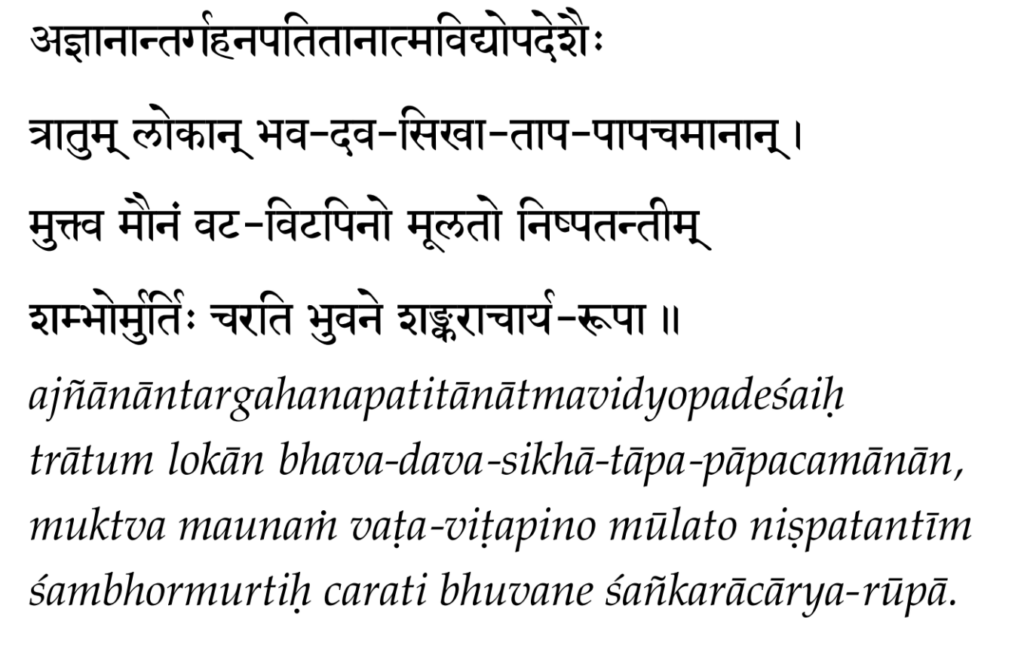
Lord Śiva (as Śrī Dakṣiṇāmūrti) gave up the silence, came out of the root of the banyan tree and is moving about on the earth in the form of Śaṅkarācārya, to save the people who are fallen in the deep forest of ignorance and who are scorched by the heat of the flames of the fire of forest of saṁsāra, by imparting the teaching of self-knowledge to them.
The embodiment of Lord Śiva or Śrī Dakṣiṇāmūrti, in the form of Śrī Śaṅkarācārya, is traveling around this world. What is the need for Lord Śiva to take an incarnation as Śrī Śaṅkarācārya? Because people are all lost in the forest of ignorance. Very often, saṁsāra is compared to a forest or an ocean. What kind of forest is it? It is one, in which we are completely lost. Forest is perhaps very nice to look at from a distance, but there is no easy to get out if you are lost inside. Wherever you turn, you find all kinds of problems like thorns, bushes etc. Similarly, we can easily get lost in life if we don’t find any direction, if we do not know our way. Further, imagine what would happen if there is a forest fire? People are lost in the forest fire of saṁsāra and, further, the flames of pain and suffering are scorching them from all directions.
Out of compassion, the Lord or the teacher wants to save the people suffering amidst the flames of the fire of saṁsāra, by the upadeśa, the teaching, of ātmavidyā, self-knowledge. There is no other way that the people who are trapped in saṁsāra can be saved. There is no other real way to help us, to save us from the forest of pain and suffering. We have many things that can save us from difficulties, but there is no means other than self-knowledge to save us from sorrow. Sorrow is caused by the ignorance of one’s true Self. Not only do I not know who I am, but I also know myself wrongly. Not knowing the fact that I am what I am seeking to be, not knowing the completeness or the wholeness that is my true nature, I take myself to be incomplete, and find myself helpless. Hence, I am constantly suffering from fear, helplessness, and a sense of persecution. This is called saṁsāra, life of suffering. All the attempts that I make to become free from this suffering seem to only increase or intensify my suffering.
Lord Śiva first appeared as Śrī Dakṣiṇāmūrti because there is no means other than self-knowledge, to save the human beings. He appeared as seated under a banyan tree and imparted knowledge to sages like Sanaka, Sanandana and others through a silent sermon. In the time of those sages, that was adequate. The sages came to him and he was able to impart self-knowledge to them. These days, however, people don’t come that easily for this knowledge. Sitting under a banyan tree in a silent sermon is not going to work in modern times. Therefore, Lord Śiva thought that the time had come to reach out to where the aspirants were and teach them through oral discourses. He took the embodiment of Śrī Śaṅkarācārya, and went around the world. A well and a river are both sources of water. However, in case of a well, you must go to the well and fetch the water to quench your thirst. Whereas, the river comes down to us, traveling several hundred miles from inaccessible places in the mountains, to quench our thirst. I guess, even during the time of Śrī Śaṅkarācārya, there were not enough discriminating people who sought this self-knowledge. Therefore, like a river, he went to the people.
Lord Śiva gave up both the maunam or silence and also the banyan tree. He gave up both, and traveled all over this earth, imparting self-knowledge to people out of compassion. That is Śrī Śaṅkarācārya. As far as we are concerned, he is the greatest person that we know of. There are other sages that we hear of, but Śrī Śaṅkarācārya?s greatness is evident to us in the form of his work. One of his best contributions is the compendium of bhāṣyas or commentaries that he wrote on the prasthāna-trayī, ‘the three basic scriptures’: the ten major Upanishads, the Bhagavad Gita and the Brahma-Sutras. He gave us the key to open the secret of this knowledge. There are texts called Śaṅkara-Dig-Vijaya, describing the life of Śrī Śaṅkarācārya, written by his various disciples and other scholars. Of these texts, one written by Vidyāraṇya Swami is very famous. There, he says that the Brahma-Sutras written by Veda Vyāsa, also known as Sage Bādarayana, is a very beautiful garland with flowers in the form of passages culled from the garden of the Upanishads. However, even scholars did not understand the sūtras or aphorisms. Therefore, the Brahma-Sutras did not serve their purpose of communicating the teaching of the Upanishads. Imagine a very precious necklace displayed by a jeweler in his showroom. People come there, look at it and then go away because they do not have the money to buy it. Similarly, Veda Vyāsa wrote the Brahma-Sutras, a very beautiful necklace of knowledge and displayed it. The scholars did come, and looked at it, but then they went away because they had no ‘artha’. One meaning of the word, artha, is money. The other meaning is ‘meaning’. The scholars could not benefit from it because they did not have artha; they could not understand the meaning of the Brahma-Sutras. Then came Śrī Śaṅkarācārya, who wrote a bhāṣya on the Brahma- Sutras. He thus gave artha, meaning, to all the scholars, and gave them the ‘money’ to buy the necklace. The beautiful necklace of the Brahma-Sutras now adorns the neck of all the scholarly people.
Pujya Swami Dayananda Saraswati embodies compassion
Asmadācāryaparyantām. Then we come down to our own ācārya. Amongst other things an ācārya is a wise and compassionate person. Śrī Śaṅkarācārya himself describes wise people in the Vivekacuḍāmaṇi [37] as follows:


Such composed, great, saintly people do live doing good to people, like the spring season, themselves having crossed the frightening ocean of saṁsāra and making other people also cross without any expectation in return.
These great people, śantāḥ, enjoy total tranquility in their mind because even the most unfavorable circumstances cannot provoke them. They abide in the knowledge of the Self that is complete, self-sufficent. Mahāntaḥ, mahātmās. One definition of a mahātmā is one who is large-hearted, meaning one who can accommodate anything. A mahātmā?s heart is as large as brahman itself. Brahma veda brahmaiva bhavati, the knower of brahman becomes brahman [Muṇḍakopaniṣad, 2-3-9]. Therefore, they have become limitless by knowing the Self or brahman, the limitless. As a result, they enjoy this large-heartedness and can accommodate anyone and anything. Only then, can there be compassion. True compassion can be there only when one can accommodate and accept another person, irrespective of how the other person is. Adveṣöā sarvabhūtānāṁ maitraḥ karuṇa eva ca, the one who has no hatred for all beings, who has the disposition of a friend, and who is compassionate [Bhagavadgita, 12-13]. These great people have no dveṣa, hatred. Not only do they not hate anyone, but they also show their affection towards everybody with karuṇā, compassion flowing from the heart. Śrī Śaṅkarācārya says this kind of a teacher is ahetuka-dayā- sindhur-bandhurānamatāṁ satām, an ocean of compassion with no motive whatsoever, who is a helpful friend to the seekers who salute him with appreciation [Vivekacuḍāmaṇi, 33]. He is one who is, in fact, an ocean of compassion. What is the reason for compassion? Ahetuka, there is no reason why they are compassionate; it is their nature to be so. There is no reason for why they do what they do. They are bandhus, brothers, friends, relatives, protectors, well-wishers, and benefactors of all those who seek refuge in them. These great people enjoy tranquility, are large-hearted, and are compassionate. Their compassion is evident in other ways also.
Vasantavallokahitaṁ carantaḥ. They don’t just sit in one place, but like the season of spring, go around the world. Wherever the spring goes, it spreads beauty, colors, and joy. Similarly, wherever these great people go, they spread joy by their very presence. But why do they do this? They are totally committed to the well-being of people because they have no agenda of their own. What do you do if you have no agenda? A wise person becomes free from the need for an agenda to such an extent that he has no free will. In fact, the definition of freedom is ‘freedom from any need to exercise the free will’. The Vivekacuḍāmaṇi compares a wise person to a dry leaf falling from the tree. The leaf goes wherever the gust of wind takes it. Similarly, a wise person goes wherever the wind of prārabdha, destiny, takes him. This is most amazing. We always glorify the free will. But what is true freedom? It is freedom from the need to exercise the free will. It means that a wise person is one who has completely submitted or offered himself at the altar of prārabdha, destiny, or the altar of God. He has no agenda of his own and, therefore, becomes a fitting instrument in the hands of God to carry out whatever agenda God has for him. The Lord wants to get a lot done. He tries to do that though us, but we do not fulfill his wishes because of our ahaìkāra and mamakāra, the notions of ‘I’ and ‘mine’. Very often, we become obstacles in fulfilling the Lord’s scheme. The wise, however, have no agenda, no ego or sense of ownership, and are like the flute held at the lips of Lord Krishna. The flute offers no resistance at all. It makes itself completely available to the Lord to play whatever tune he wants to play. So also, as instruments in the hands of the Lord, the wise go around the world spreading the joy of knowledge and living for the well being of the people.
They themselves have crossed this terrible ocean of saṁsāra and they help others also to cross the ocean of saṁsāra. In this manner we come down to our teacher, Pujya Swamiji. The verse quoted above describes him very well. Thus do we salute this guru paramparā, this lineage of teachers.
We as students of Vedanta are very fortunate
If we see the tradition extending down to us, we should congratulate ourselves too, because, again, the Vivekacuḍāmaṇi [3] says:

The status of a human being, the disposition of one who longs for freedom, and being under the tutelage of a teacher – this three-fold blessing is difficult to gain and has its cause only in the grace of the Lord.
These three are rare indeed, and they can be obtained only by the grace of God. So we must have done something right to deserve to be where we are. To gain this human embodiment is something very rare because we could have been in any one of the many million embodiments that exist in this universe.
Again, there are billions of human beings on this earth now, but we find that most people have no value for Self-knowledge. The Kaöhopaniṣad [1-2-7] says, śravaṇāyāpi bahubhiryo na labhyaḥ, this knowledge is not available even for listening, for most people. Mumukṣutvam. We are further fortunate that we have discovered an urge for Self-knowledge. We possess an urge for freedom and have jijṅāsa, the desire to know, which is very rare. We have discovered that freedom can be obtained through knowledge with viveka or discrimination. Everybody wants to be liberated, everyone wants to be free, but there are very few who have discovered the fact that the freedom can be gained only through knowledge.
Mahāpuruṣasaṁśrayaḥ. We also have sought the refuge of a mahāpuruṣaḥ, a great soul in the form of our Pujya Swamiji. We are extremely fortunate that we have this privilege. Therefore, we also must have done something right.
We, who are extremely fortunate, salute guru paramparā, this lineage of our teachers. This is the purpose of Gurupūrṇimā, Teacher’s Day, and it is not only the Teacher’s Day, but it is Disciple’s Day as well because it is our privilege to be able to offer our sense of gratitude and prayers to our teachers.
May we gain the grace of all our teachers: Lord Dakṣiṇāmūrti, Śrī Śaṅkarācāryaji, and of our own Pujya Swamiji. May we always enjoy their grace so that we remain steadfast in this path and do not swerve. May all internal and external obstacles be removed from our path so that we can march along in our journey towards self-growth and self-knowledge, and ultimately to total unconditional freedom or mokṣa.
